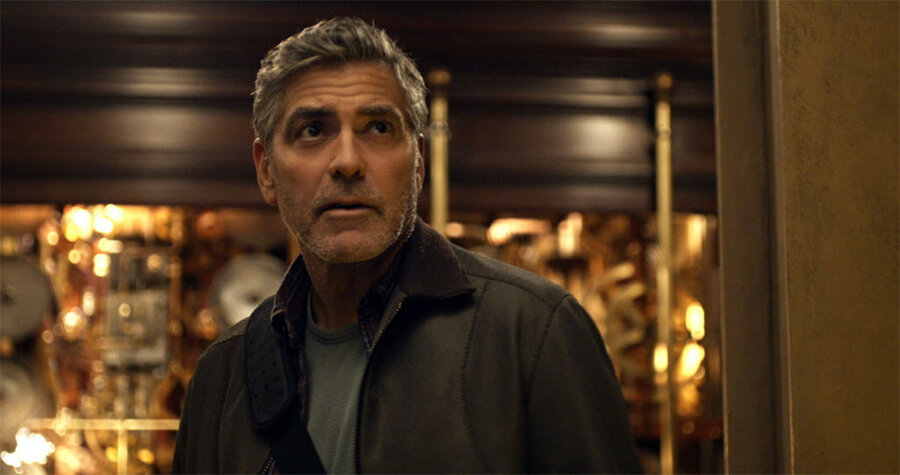'Tomorrowland' aims to bring the fun back to the future
Loading...
For writer Damon Lindelof, the genesis of the escapist adventure "Tomorrowland" was one very simple question: What happened to our jet packs?
When he, director Brad Bird, and George Clooney were children (albeit at slightly different times), the future seemed like something great. To them, it was full of wonder around the gadgets and inventions that populated their entertainment and sparked their developing imaginations.
Clooney, who was born in 1961, just as the Space Race was picking up, remembers its influence on his youth.
"My whole childhood was eating space food sticks and drinking Tang," he said in a recent interview with Bird and Lindelof.
By the time Clooney was 8 years old, a man had already walked on the moon.
Even amid the political and social turmoil of the time, it was hard for them not to look at everything with such rose-colored glasses – especially with Walt Disney as a consistent and persuasive advocate for optimistic futurism. Disney, in his television series "Disneyland," would present scientific ideas to his young viewers and speculate on what the future might hold.
"We were fairly positive that at some point in our lifetime, the world was going to end in a nuclear holocaust. That was a real possibility," said Clooney. "It was as bad as anything you see today, but we all thought something was going to work out."
Bird, born in 1957, said that Disney's influence on that can-do attitude of the era was undeniable.
"He was this hub of imagination. Every time that he talked about the future, it was fascinating and it was fun and it was bright and it was like all these great things are going to happen," said Bird.
And then, of course, there was Tomorrowland itself. The area of Disneyland opened in 1955 and imagined what 1986 might look like. Disney called it a "step into the future, with predictions of constructed things to come." (The Tomorrowland section of Disneyland isn't physically portrayed in "Tomorrowland" the movie. Rather, it exists more as an abstraction and the film's undeniable inspiration.)
From the Moonliner's "trip to the moon" to the Carousel of Progress, Tomorrowland shaped the minds of generations of kids. For Bird, the best version of Tomorrowland was the one that opened six months after Disney's 1966 death and represented his complete vision.
Even Clooney had an early transformative experience at the park.
"I was 6 when I went there and it was fascinating. Tomorrowland was going to be the future. I thought that's what it actually was going to be," said Clooney.
But something happened in between, and our collective attitude about what's to come has soured for many.
"That idea of you being personally responsible for your own future – where that future is potentially fun – has started to slip away," said Lindelof, who was born in 1973.
Bird added: "We've been gradually prepared for the idea that the future is going to stink. It's happened so slowly that we haven't really noticed it."
That's where the Disney movie "Tomorrowland" kicks off. In a story developed by Lindelof, Bird, and longtime Entertainment Weekly writer Jeff Jensen, a boy genius turned pessimistic adult grump (Clooney) gets entangled with a driven and bright dreamer, Casey (Britt Robertson), who endeavors to go to "Tomorrowland" and fix what's been lost: Optimism.
Part of that involved Clooney taking a backseat to the young female protagonist in the film.
"In my 30s, I got to punch the guy and fall on the ground and walk away and there are explosions behind me as I'm walking toward the camera. Now I'm the guy who gets socked in the face, who falls on the ground and who whines a lot," said Clooney.
In many ways, "Tomorrowland," in theaters now, is a response to modern cynicism, often most evident on social media. When "Tomorrowland" was under development, for example, it used the code name "1952."
During that same time, Disney acquired Lucasfilm, Lindelof said, and "people were 'like 1952 and 5+2=7, so you guys are doing "Star Wars VII'" and Brad had to tweet 'We are not doing "Star Wars.'"
"That turns into 'Bird says he'll never do Star Wars!'" added Bird. "You can be incredibly well-intentioned in that space and just want to put out positivity and it will turn on you."
By embracing an original idea with "Tomorrowland," Bird also believes the film is a response to the standardization of summer movies – all superheroes and sequels. It's a brave thing to go against the mold, especially this earnestly.
"Not everything is based on a comic book," said Bird. "People say that they want to see something original and there is a way to do that," he added, even though "Tomorrowland" is technically based on an area in a theme park.
Doing that meant fully committing to the spirit of optimism, even if it is a bit retro, simplistic and possibly naive. But that's their point: To inspire a new generation of unjaded innovators.
"We're not afraid to make a movie that could be perceived by some as corny or hopeful or unrealistic," said Bird. "You have to have the dreamer in order to do the dream."
Perhaps then Lindelof will get his jet pack.







